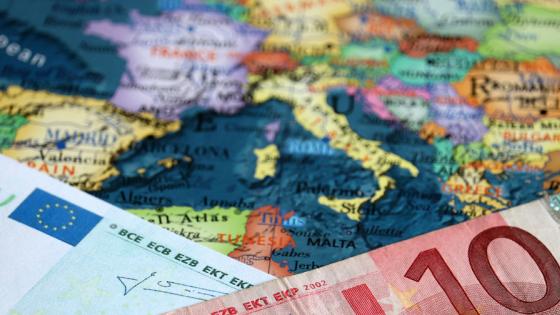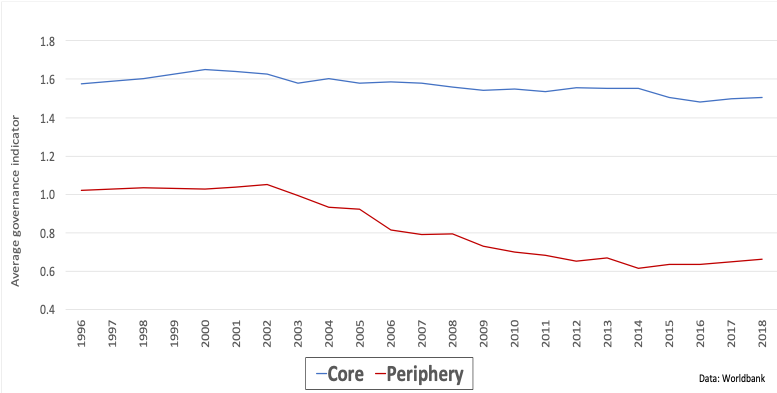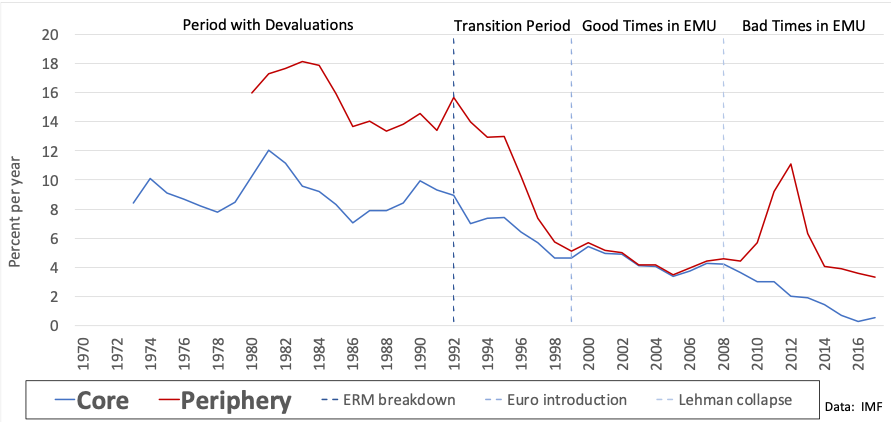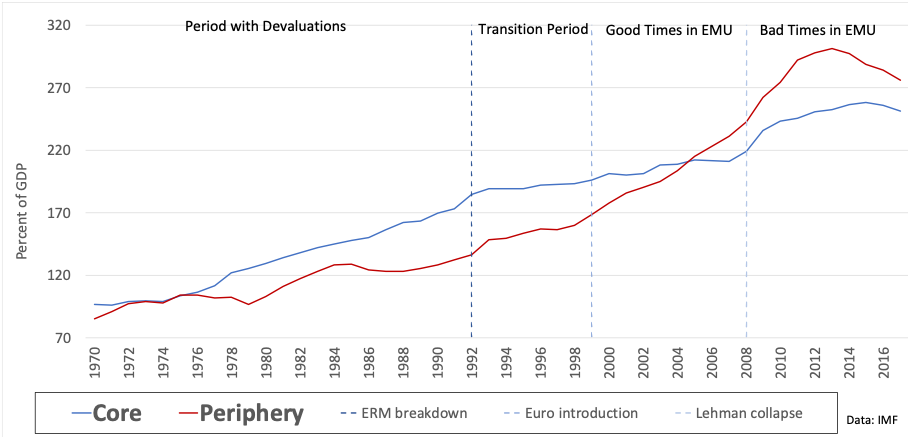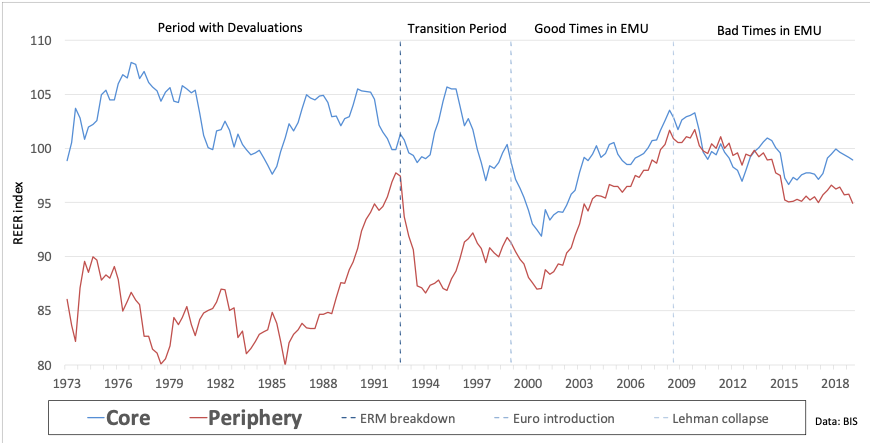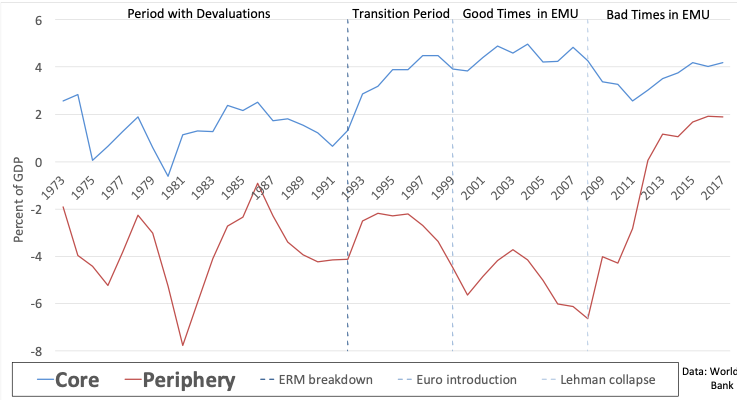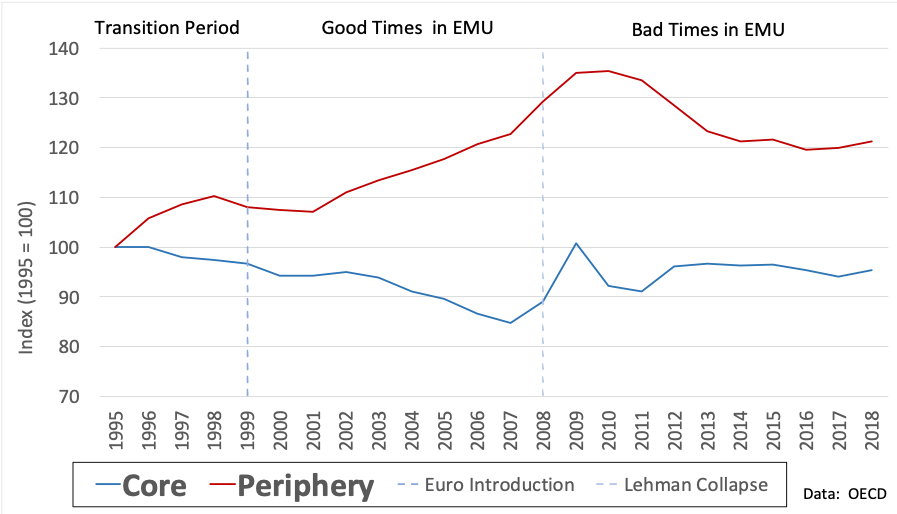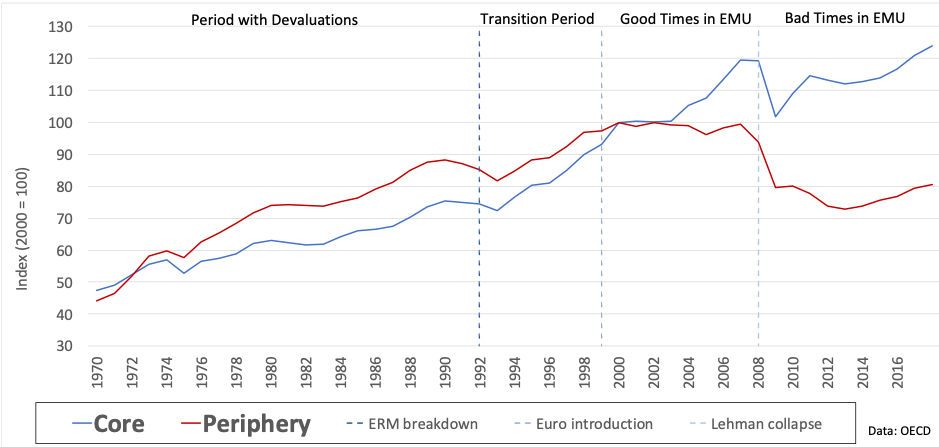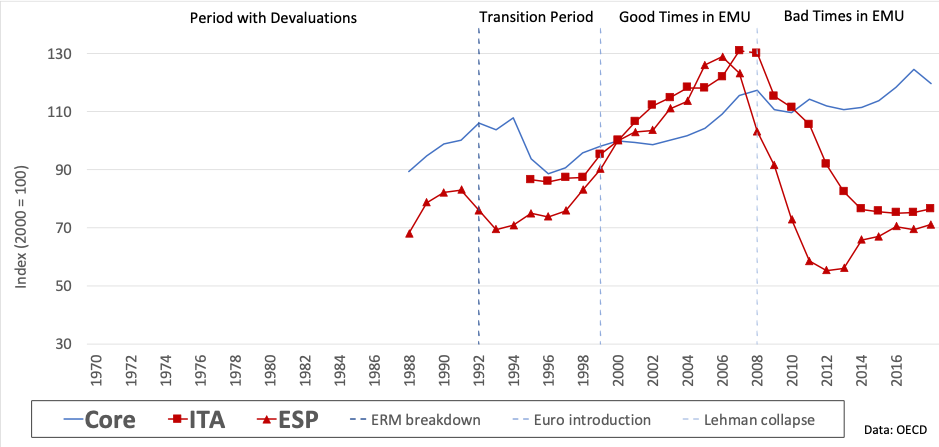Since 2008 the euro has been plagued by fragility. This has led to sharp disagreements among its members, especially on the legitimacy of cross-border support for periphery countries that were struggling fiscally. Most attribute the disagreements to the euro’s design as an institutionally diverse monetary union, without a common fiscal framework.
A general equilibrium analysis of the implicit exchange rate effect offers perspective. The core’s relative success may be partly down to its institutions, but also to the favourable redistributive effects of a common currency. And the periphery’s difficulties reflect less-restrained spending, but also a higher real fiscal burden induced by the euro.
As Martin Wolf wrote in the Financial Times, the euro area "protected Germany from becoming another Japan. Germans should be thankful for what the euro has given them.” (Wolf 2019).
A general equilibrium analysis
North (1991) and Acemoglu et al. (2005) argued that governance and contractual institutions reflect deep societal characteristics that shape private and public choices. The euro was seen as an economic and political half-step that was justified by its trade and diversification gains. This envisaged gradual convergence as an act of will. But the vision dramatically underestimated the persistence of institutional differences.
In a recent paper, we offer some perspective by analysing the general equilibrium outcome of an union among institutionally diverse members, highlighting its redistributive effects (Perotti and Soons 2019). The key insight comes from recognising that market prices and flows adjust rapidly, while wages and productivity adjust much more slowly. However, deeper institutions are persistent even in the medium term.
Institutional differences within the euro area are large, and did not converge with its creation (Figure 1). Political systems under weak institutions have a tendency for excessive public spending or guarantees.1
Figure 1 Differences in institutional quality in the euro area, 1996-2018
Source: Perotti and Soons (2019).
The financial effects of a diverse monetary union
The euro relaxed financial constraints in periphery countries, but greater borrowing led to a sharper downturn. Periphery countries benefited from better financial access at the cost of relinquishing the valuable option to devalue (Italy devalued 13 times between 1979 and 1992). The immediate effect was a major trading and financial integration. Borrowing costs for periphery countries decreased as currency risk evaporated and the devaluation premium fell (Figure 2), allowing for a higher dollar value of sovereign debt.
Figure 2 Long-term interest rates core and periphery in the euro area, 1973-2017
Source: Perotti and Soons (2019).
Political reluctance to share (or relinquish) fiscal policy implied that Maastricht fiscal rules were soon breached by both core and periphery countries (see Figure 3 for the trend in private and public debt over GDP). Cheaper borrowing was traded against a higher real cost of public debt, enabling greater borrowing (Greece, Portugal), maintaining excessive debt (Italy, Belgium) or used for massive private borrowing under a public backstop (Portugal, Spain, Ireland). Most capital inflows inefficiently funded non-tradables, harming competitiveness further (Brunnermeier and Reis 2015, Gopinath et al. 2017). This financial relaxation in good times hid a greater fiscal burden in economic downturns.
Figure 3 Total debt core and periphery in the euro area, 1970-2017
Source: Perotti and Soons (2019).
The competitiveness effect of a diverse monetary union
Besides the visible interest and credit volume effects, the hidden effect of a common exchange rate on competitiveness was massive, an effect already described in Frieden (1998). And so a common currency among diverse countries produced a revaluation for periphery economies and a devaluation for the core.
Figure 4 shows exactly this evolution of core and periphery real effective exchange rate (REER), an indicator of a country's exchange rate competitiveness relative to its trade partners.
Figure 4 REER core and periphery in the euro area, 1973-2019
Source: Perotti and Soons (2019).
Our work shows how the exchange-rate effect of a DMU increases in membership diversity (Perotti and Soons, 2019). A weaker periphery boosts the effective devaluation at the core, redistributing productive advantage and incentives on tradable goods.
The euro also created within-country redistributive effects. In countries with weak institutions, investment incentives were reduced by a revalued currency. This hurt productive forces and tradable sectors, while boosting (temporarily) nontradable and savers. At the core, the opposite happened. Younger (productive) generations benefitted, while retirees lost some purchasing power.
The impossible pace of institutional adjustment required by a rigid monetary framework thus caused the euro to be a transfer union from day one, even before explicit fiscal transfers take place. But this general equilibrium effect was not visible, meaning core countries attributed their relative success entire to their fiscal restraint rather than an implicit monetary adjustment that had been caused by the euro.
Evidence on the 'hidden exchange rate' effect
Figure 5 offers suggestive evidence. Core countries historically had a better trading position which steadily improved after the euro was introduced, while the performance of the periphery deteriorated. Core countries also outperformed non-euro OECD countries with comparable institutional quality, while periphery countries underperformed them. The effect was particularly noticeable in the countries with the most extreme institutional ranking – Italy and Greece on one hand, and Germany and the Netherlands on the other.2
Figure 5 Trade balances, core and periphery in the euro area, 1973-2017
Source: Perotti and Soons (2019).
This pattern of exchange rate convergences and trade divergences was already evident during currency realignment attempts that predated 1992. The euro monetary unification created a rigid 'monetary cage'.
This is visible in the relative rise in real unit labour costs in periphery countries, and the drop in output after the euro (Figures 6 and 7). National wages tend to adjust more slowly than prices, and wages, especially in the nontradable sector, were boosted by euro-induced expansion. This compounded the required adjustment.
Figure 6 Manufacturing unit labor cost core and periphery in the euro area, 1995-2018
Source: Perotti and Soons (2019).
Figure 7 Manufacturing output core and periphery in the euro area, 1970-2018
Source: Perotti and Soons (2019).
Countries with significant manufacturing and weak institutions suffered most from the revaluation effect, and were less able to adjust when the recession forced ever-higher taxation. Nontradables were temporarily boosted by capital inflows (Figure 8).
Figure 8 Construction output core and periphery in the euro area, 1988-2018
Source: Perotti and Soons (2019).
Conclusions
A common currency between strong and weak members has structural consequences, as market prices and flows will adjust while national institutions cannot adjust simply as an act of policy.
If the euro makes fiscal imbalances heavier to bear at the periphery, and lighter at the core, this suggests a more complex narrative than a simplistic view that blames cultural traits. Politicians and their voters at the core have also tended to congratulate themselves for their success under the euro. They should revise this point of view.
The creation of Europe’s diverse monetary union had economic and politicial motives. Core countries benefitted from a devalued currency that underpriced their comparative advantage; periphery governments gained monetary credibility and funding capacity, but boosted nontradable sectors at the cost of productive incentives. This further weakened their fiscal capacity in the recession.
The euro's creators underestimated the extreme challenge of adjustment, although they had recognised that the burden of that adjustment would fall on weaker members. The euro survival that benefits its core also requires some fiscal solidarity, legitimised by its implicit gains. Yet even a legitimate transfer is politically unacceptable to a perceived profligate spender, so an institutional shift needs to come from outside.
As Farhi and Tirole (2017) stated in the context of a banking union, “[W]ith an externalisation of supervision … all (countries) can be made better off by combining a commitment to solidarity.”
A stable future for the euro also requires an externalisation of fiscal authority. In the US, state spending discretion is constrained as the federal budget is not responsible for the debt. A centrally funded federal budget can rebalance the gains from trade more credibly than fiscally sovereign states, so a structural shift in specific spending authority or competences must complement fiscal solidarity.
Imposing strict conditions for support – as in Scholz (2019) – is self-righteuos and doomed to fail. It ignores the structural tension in the euro architecture. On balance, the long-term benefits of the euro require a wiser approach than the nationalist blame game.
At a minimum there is legitimate cause for mechanisms of mutual support, such as a common euro safe asset.
References
Acemoglu, D, S Johnson, and J A Robinson (2005), "Institutions as a fundamental cause of long-run growth", Handbook of Economic Growth 1A: 385-472.
Alesina, A, R Baqir, and W Easterly (1999), "Public Goods and Ethnic Divisions", The Quarterly Journal of Economics 114(4): 1243-1284
Brunnermeier, M K, and R Reis (2019), "A crash course on the euro crisis", NBER working paper w26229.
Farhi, E, and J Tirole (2017), "Deadly embrace: Sovereign and financial balance sheets doom loops," The Review of Economic Studies 85(3): 1781-1823.
Frieden, J (1998), "The euro: Who wins? Who loses?", Foreign Policy 112: 25-40.
Gopinath, G, Ş Kalemli-Özcan, L Karabarbounis, and C Villegas-Sanchez (2017), "Capital allocation and productivity in South Europe", The Quarterly Journal of Economics 132(4): 1915-1967.
North, D C (1991), "Institutions", Journal of Economic Perspectives 5(1): 97-112.
Perotti, E C, and O Soons (2019), "The Political Economy of a Diverse Monetary Union", CEPR discussion paper 13987.
Scholz, O (2019), "Germany will consider EU-wide bank deposit reinsurance", Financial Times, 5 November.
Wolf, M (2019), "How the euro helped Germany avoid becoming Japan", Financial Times, 29 October.
Endnotes
[1] Excess spending under weak institutions is usually seen as abuse of power (corruption due to poor accountability). A more perceptive view is that it may also be a political necessity. Internally divided countries often need spending to appease conflicting interests and maintain power (Alesina 1999). But, in either case, weak institutions lead to excessive public spending.
[2] While Germany had reformed its labour markets after unification, it struggled before the euro with a loss of competitiveness deriving from the one-to-one conversion of the Oostmark.
